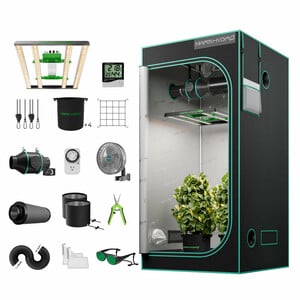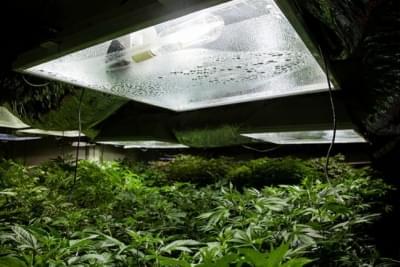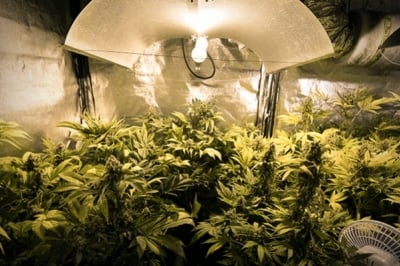.

Tips for Silencing Your Cannabis Grow Room or Tent
Spending ages setting up your grow room or grow tent, only to find that it emits a loud, constant shuddering noise can be frustrating. But fear not! Whether you're growing in a tent or a room, here are a few easy tips to reduce the noise and keep your cannabis grow subtle and stealthy.
Contents:
There are many things to master when it comes to growing cannabis. Most of these skills and techniques surround getting the most and best-quality bud. However, this is not all. The perfect grow doesn't just yield a good crop, but makes the process enjoyable, safe, and discreet as well. Given that, reducing noise within your grow is one of many goals for the expert cultivator.
Cannabis Cultivation: Silence Is Golden
Having your very own cannabis grow is a wonderful thing; but having it roaring away all day and night can become a bit of a nuisance, at best. At worst, it could attract a visit from the police.
Therefore, silencing, or at least muffling, the noise produced by your grow is a key aspect of most good grow spaces. There will of course be those who are lucky enough to allow it to make all the noise it wants, but for most of us, a quiet grow is a happy grow!
4 Tips for Silencing a Grow Tent
So, without further ado, let’s look into the ways you can make your grow subtle and quiet. We’ll begin by looking into the specific ways we can silence grow tents, in which most small-scale growers are likely to cultivate their crop. Later on, we’ll look at noise reductions for grow rooms too.
1. Mount Your Extractor Inside the Tent
First things first; the best thing you can do is get everything inside your tent. The tent itself will insulate a lot of the sound produced by various parts of equipment—and if you follow these steps, it will insulate even more.
Your extractor fan is likely to be large and bulky, and as such you’ll probably be tempted to mount it on the outside of the tent for ease. While this is tempting, it is also one of the noisiest pieces of equipment, and therefore mounting it inside the tent has significant value.
To do this, it’s best to use the tent’s ceiling bar(s). Using clips and bungee cords, you should be able to suspend the inline fan comfortably inside the tent. Bungee cords are brilliant friends in the quest for quietude. Their flexibility means that they will absorb the vibrations emitted from pieces of equipment, further helping to reduce noise. Not only will they stop your tent from becoming an amplifier, but they will help to keep it structurally secure as it won’t be subjected to constant shuddering.


2. Modify the Fans on Your Grow Light
This one can be a little tricky, and is only recommended if you’re confident with your DIY skills. LED grow lights run cool, and as such come fitted with the same fans as computers. While they’re pretty quiet already, they can still whir annoyingly when they get hot—as anyone with an old computer is likely to know.
However, it’s very possible to remove the fans they come fitted with and instal ultra-quiet ones. The process will depend on which lights you have, but it shouldn’t involve much more than taking off the outer casing and replacing the fans.
For some, this method might be unnecessary as LED lights are fairly quiet anyway. But if you’ve got a grow tent in a room you spend a lot of time in, it’s probably a worthwhile effort.
3. Consider Switching to LEDs
If you’re still using old-school light setups, such as HID lights, then switching to LEDs will quieten things down a lot. Older lights emit a load of heat, and as such require a large amount of extraction to keep grow spaces cool enough. LEDs, on the other hand, emit almost no heat, and so extraction is greatly reduced.
This means that instead of having a giant fan sucking the air out of your grow space, you can get away with a much smaller—and much quieter—alternative. By doing this, you’ll be saving space and energy. A double victory!


4. Seal All Optional Openings
It’s not only light that seeps through the cracks. Any noise will squeeze its way through openings in your grow tent and find its way into the outer world. So seal those openings!
A soundproof grow tent is an easy and effective way of keeping a grow quiet. Grow tents, by default, come with lots of different openings so you can run wires, hoses, ducts, and equipment in and out of them. Very handy when you need them; noisy when you don’t!
They’re simple enough to seal, though. Depending on the opening, you have a couple of options. First, you can duct tape them closed. If you do this, it’s probably worth doing it on both the inside and the outside—just to be sure that you have a decent seal. For larger openings, consider cable-tying cloth over it. The cloth will absorb much of the noise and act as a very good seal.
Sealing openings is essential for growing photoperiod plants anyway, so it’s worth doing it well whatever your motive. Light leaks can stunt growth, cause plants to revert to the veg stage, and create all manner of other issues. So don’t skimp on this.
4 Tips for Silencing a Grow Room
For those who have the space to dedicate entire rooms to growing, noise is likely to be more significant. Likewise, a room will probably absorb most of the sound emitted from a grow tent—so it might be annoying in the building, but probably won’t attract the attention of neighbours. Grow rooms, on the other hand, might be significantly more audible, and silencing them is not just a matter of preference, but often essential.
1. Soundproof the Room
Effectively soundproofing the room is your best bet when it comes to reducing the noise of your cannabis grow room. Depending on how much effort you want to put in/how much you want to permanently change the room, there are a number of things you can do.
Perhaps the simplest and most reversible option is to instal vinyl hangings, like curtains, over the walls. These will absorb much of the sound, rather than it vibrating through the walls. You could also put soundproof underlay on the floor. Despite being underlay, you can temporarily put it on top of the existing flooring.
The most extreme option, and this is only worth it if you intend to grow in the room regularly, is to cover the walls with soundproof plasterboard. This boarding is specifically designed to absorb noise. You can even double-board, a technique used by some builders, which will seriously dampen any sound produced in the room.
As mentioned with the tent, all ducting and fans should be suspended from bungee cords, which will stop the vibrations from entering the larger structure.


2. Try Insulated Ducting
Metallic ducting probably looks the coolest, but it's also the loudest. Think of the resonance produced by metal compared to other materials, such as fibreglass. Using noise-reducing ducting will stop the constant rattling sound you may otherwise encounter.
Failing that, insulating it yourself is simple and effective. Either build insulated wooden or plastic casing to go around your ducting, or even wrap it in insulation, such as Rockwool. Basically, anything to absorb the brunt of the metallic shuddering will make a big difference.
Finally, anything that sits on the floor is worth laying on something soft, such as a yoga mat. This is particularly useful with things such as pumps, which cannot be insulated for safety reasons. As they emit a lot of heat, wrapping or boxing them up could cause them to set alight, which is far more annoying than a quiet rumbling!
3. Use Extra Air Stones in a Hydroponic Setup
Air stones attached to the pump in a hydro setup can determine how much noise the pump will make. Blocked or old air stones will cause the pump to work more loudly. Therefore, at the very least, replace your air stones regularly to keep it working efficiently.
If you really want to quieten it, consider adding extra air stones to minimise the amount of effort your pump has to put in, keeping it quiet, cool, and energy efficient.
4. Add a Ventilation Muffler
The exhaust duct in your extraction system will probably be the culprit responsible for the most noise in your system, so muffling it is key. Some systems may come with mufflers, or you may be able to buy them. If this is an option, it makes your life very easy.
It could be expensive, though, and so you might want to consider making your muffler at home.


Making Your Own Muffler
Making a sound muffler for your room is simple, cheap, and if you like making things, fun as well. Though the size may vary, this is a key element of a soundproof grow tent or a soundproof grow room. Following these instructions should have your ventilation system muffled for very little money.
Equipment
- 200-litre plastic trash bin with lid
- Some metal netting (aka “chicken wire”, “hex netting”, etc.)
- Silicone gun
- Duct tape
- Insulation (such as Rockwool or quilt batting)
How to Make a DIY Exhaust Muffler
- Make a tube the same diameter as your ducting from the metal netting. Make it slightly longer than the length of your bin.
- Now, cut holes in each end of the bin so the mesh tube can snugly fit through. Feed it through with 5–10cm coming out each end.
- Using silicone and duct tape, secure the mesh to the inside of the bin.
- Now, use your insulation to fill the spaces between the outside of the mesh and the inside of the bin. There is no need to pack it too tight. Wear gloves, a mask, and goggles as fibreglass insulation is highly irritating—and you will spend the rest of the day in pain if you don’t!
- Use duct tape and silicone to fix the lid closed. Then, use duct tape and silicone to seal the outside of the holes where the mesh goes into and out of the bin.
- Feed your new muffler over your exhaust ducting. All going well, it should fit like a glove!
Keep Your Indoor Cannabis Grow Quiet
Whether it's for your own quietude or to enhance the stealth credentials of your grow, noise reduction is likely something you will consider at some point. There’s no need to use every technique mentioned here, and you’d do well to adapt them to the specifics of your grow. In most cases, grows are a mix of predesigned equipment and things we’ve cobbled together ourselves, so flexibility and ingenuity are key!









































